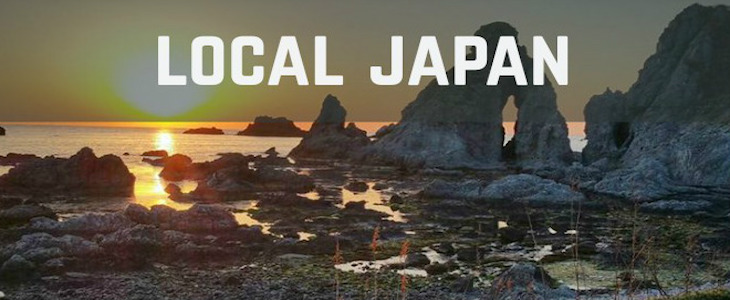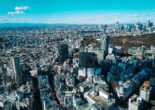
Local Japan: Sado Island – Life on Japan’s sixth largest island
I’ve often thought of Sado as Japan in one place. Many people in the past came from around the nation, or rather were sent to work in the gold and silver mines. This brought bits of their Japan and their language with them to be blended with what was already here. For many Japanese unfamiliar with Sado the island still has that image of a penal colony. And many are unfamiliar with Sado being a two and a half hour ferry ride from Niigata city into the Sea of Japan. It’s that island that looks a bit like a Z. If you ask someone outside of Niigata prefecture about the island they will probably say Toki (The Crested Ibis successfully reintroduced here) cold winters and maybe great seafood. I too knew very little about it even though I had lived in Japan eight years. I remember one student where I was living in Saitama telling me with great passion how he and his grandson loved to go there for their summer holidays. The fantastic coast, the swimming spots and beaches. The fact that there were no train lines. He seemed so curiously intrigued with this fact that it stuck with me. It certainly is big enough ( 855.26 km2) to warrant the odd line here and there. It even has an airport but alas – no planes. The runway is too short. So if you are coming or going it is probably by ferry or the pricier, weather permitting but much quicker one hour jet foil. So it was with my student’s glowing appraisal in mind that I decided on an impromptu trip to see for myself. After a three hour-ish Shinkansen trip to Niigata City from Tokyo and a few beers on the ferry over I found myself in Ryotsu port at the start of my trip and unknowingly the start of a new life as I promptly ran into my wife to be.
We now live on the island renting a big old house at the foot of the largest mountain in the Oosado range, with views overlooking the other, smaller Kosado range and rice fields stepping down to one of the few main roads. The house, as many here do, has a small wood on one side to offer protection from winds and a large vegetable plot with a few fruit trees. Life is slow and easy. Rents can be much much lower than on the mainland. The sky is big and the stars many. Watching the seasons here change is a privilege I am thankful to be able to witness. Nature has become a much bigger part of my life than before. My first three years in Japan were spent in Tokyo and then six years after that in a small city in Saitama. All have their merits. My Japanese is frustratingly not nearly as good as it should be considering the length of time I have been here. That is changing though as there is no English bubble to live in on the Island, just a variety of different and new dialects to navigate. Oh how I wish I had studied more. Workwise I teach English from my home and I run an internet shop. Both of which I enjoy, but my options for other work are quite limited. That is something to really consider before moving somewhere like this. If you can create income through the internet then it is much more plausible. Otherwise you would need to be extremely fluent in Japanese both reading and writing (with a pen) to find other sources of work. Agriculture, fishing and tourism are the main industries.
There have been people inhabiting Sado for more than 10,000 years. During the Edo era people were sent here to mine the gold and silver that funded the Shogunate that carved the country that Japan became. Also political exiles such as Emperor Juntoku and Buddhist monk Nichiren. The cultures people brought are very much alive, kicking and preserved. In comparison to other places I have lived, Sado is easily the richest culturally. The Sado Okesa dances, the outside Noh theaters and the home of the international Kodo Taiko group. Festivals bring communities together and are keenly continued. Most notably Oni-Daiko which could be translated as ‘Demon Drums’. All year round, but mostly at the beginning of Spring, these drums can be heard both morning and evening as troupes of men practice their own particular drumming style and dance. Almost every man in each village across the island can perform it, which I think in itself is quite special. On one day of the year they will start at dawn, travelling to each house in the neighborhood performing a ritual to banish the bad and bring the good. This is fuelled by each house laying out a platter of food and drink (sake) for the performers and their entourage. Each performance and their drumming is something to behold and I marvel at how they can continue it from early morning, right through past nine at night. It is great to watch and feel the energy and festival atmosphere. Everyone working and coming together to make it happen. People working and living on the mainland return to take part in them.
Sado faces the same problems that the main land does with an aging population. The population in 1950 stood at over 120,000, double what it is today. Schools and kindergartens close or become amalgamated. The only thing you can’t find here are the skyscrapers of Tokyo. The tallest building is the main hospital, four floors and a helipad. It’s probably the busiest too. Oh and of course – train stations. Towns and villages are connected by none too frequent, but regular bus services. Relocating here without a car is not an option.
Living here means being part of the community and there is no shortage of community events in the calendar. In our community these are things such as weed whacking, unblocking the waterways, raising flag poles(at 6:30 am) to mark festivals, making traditional new year decorations and other festivities centered around the local shrine. To compare it to the UK where I’m from I’d imagine the stereotypical image of 1950’s Britain. Neighbours popping over to borrow a cup of sugar. Rarely locking the front door. Local community parties. In the winter we really relied on our neighbours to help us clear the snow. But I can imagine how being so unavoidably involved in a community isn’t for everyone.
Sado is the sixth largest island that make up Japan. The whole island since 2004 is considered logistically to be a city, Sado-Shi. The main towns are in the areas of Ryotsu, Aikawa and Sawata. Ryotsu has the main port where most ferries and Jetfoils operate. There’s a small (what I would call) town around the port with a Showa era feel shopping street, somewhat of a downtown of bars and Izakayas. A few of the large hotels. This is also where the main road, Route 350 picks up and takes you up out of the Ryotsu through Kanai where the hospital is and along into Sawata. Sawata is the main busiest stretch on the island for shops and shopping. A couple of big home centers, electrical stores, supermarkets and clothes shops. Pretty much everything you would expect to find a large town in Japan, minus only (gratefully) a Macdonalds. If you continue down the 350 you will hit the beautiful West facing Mano Bay. You have just driven across Kuni-Naka (middle country), the center of the island. From Ryotsu to Mano Bay it takes about 30 minutes. Here the 350 heads off to the south, towards Ogi and the bottom half of the Z if you like. The southern part is made up of the Kosado mountain range and north the larger Oosado range. Millions of years ago these were two separate islands. Now they are joined by Kuni-Naka. Ogi is another of the three ports which connects to Naoetsu in Niigata with regular ferries running. If you leave the 350 and head up north on Route 45 you can find Aikawa. Aikawa is home to the world heritage nominated Sado Gold Mine which is an article in itself.
The biggest annual event is probably the Kodo organised Earth Celebration, an August weekend festival of music theater and performances from all across the globe which take place mainly around Ogi and across the Island. There is also the super tough Sado International Triathalon (September) and the national Toki Marathon. Noh theatre performances are held mainly in summer through to autumn and several large firework displays. Things do slow down a lot in Winter, there is some snow (nothing crazy) and it gets pretty cold. The biggest issue with the winter is that rough seas result in ferry cancellations. Not fun when you have a plane to catch or somewhere else to be. That is certainly the biggest inconvenience that you have to make allowances for. It might mean leaving the island a day earlier just to make sure you can.
For me, it’s perfect. I love the tranquillity of rural life and I have not yet felt isolated. The plethora of festivities and events to be enjoyed all over. I like its size, not too big or small. Any event can be accessed pretty easily by car. Living fairly centrally even the farthest events don’t take much longer than an hour to reach. There always seems to be something to do. I am married to a local though and I came with established connections. Friends and family. For many it’s not an ideal place. Friends say,”it’s great to visit but I couldn’t live here”, citing a somewhat misconceived lack of restaurants, convenience and things to do. Well, I suppose that comes down to what you like doing. If it is anything to do with the sea you can do it here, especially eating from it. Geographically the island is located in a very interesting spot. There are two currents which can be fished. A colder northern one and a southern one. Each brings different catches. It is also just far enough north to grown fruit from the northern hemisphere and just far enough south to grow fruit from the Southern. Fruit trees are a common sight, especially Persimmon. Almost everything seems to grow well here. Maybe because of its volcanic past. The whole island is a registered Geopark. Drives around any coast are gorgeous and intriguing. You can find not only beaches but fascinating rock formations, mountains and ancient untouched cedar forests. Hikes through which can be arranged, but are only permitted with a professional guide to accompany you. Regular hiking can be found all over too. As can most other things you might associate with Japan, impressive shrines and temples, aging Showa era shopping streets, rice fields, traditional textiles and pottery. A strong sense of community. A safe society.



